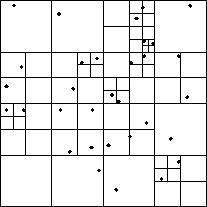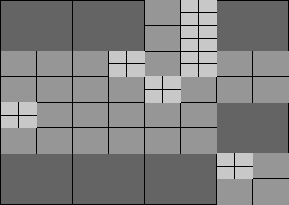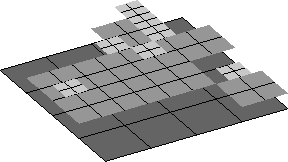
Figure 12.35: A Collapsed Representation of a Small, Two-dimensional Barnes-Hut Tree Containing 32 Particles





We propose that the exact same hierarchical structure used by particle-based methods now may be effectively utilized in adaptive mesh refinement implementation. The spatially structured cubic volumes into which the mass-points are sorted are inherently situated, sized, and ordered as an efficient adaptive mesh representing the system of interest. Instead of interpreting the hierarchy as a graphical representation of the tree-shaped database, it can function as the physical mesh which links the grid resolution with the particle density. Figures 12.10(a) and 12.35 represent a two-dimensional tree-structure from a particle simulation (simplified for ease of presentation). Figures 12.36 and 12.37 show the configuration in Figure 12.35 represented by a composite grid. The similarity between Figures 12.35 and 12.36 demonstrates the convergence of these two different approaches. Tree levels and cells may not directly correspond with grid levels and zones, that is, multiple particles (and cells) from multiple levels would be collected to form a single grid level of appropriate resolution aligned with the tree cells. Figure 12.11 shows a larger, more realistic two-dimensional tree for which we can give a similar discussion.

Figure 12.35: A Collapsed Representation of a Small, Two-dimensional Barnes-Hut
Tree Containing 32 Particles

Figure: The Flattened Tree in Figure 12.35 Interpreted as a
Composite Grid

Figure: Another View of the Composite Grid in Figure 12.36
Showing the Individual Grid Levels from Which it is Constituted
This relationship stems from the grid-based algorithm's reliance on the locality of the discrete operator and the particle-based schemes' similar utilization of locality to efficiently collect, combine, and redistribute the multipole moments. In the Poisson case, the locality stems from the regularity of harmonic functions which allow accurate approximation of the smooth, far-field solution by low-order representations [Almgren:91a]. Barnes-Hut requires the locality of the tree not just as a framework for the algorithm but to provide the ability to selectively descend into subcubes as needed during the computation, allowing Salmon to create ``locally essential'' data sets per processor [Salmon:90a]. Locality is common to and useful for many loosely synchronous parallel algorithms [Fox:88a].
This union of hierarchies provides opportunities beyond similar programming structure [Anderson:90b], [Katzenelson:89a]: It allows easier synthesis of combined particle and mesh algorithms and allows hierarchy-building developments to benefit both simulation methods. An additional advantage of the oct-tree over the binary tree (recursive bisection) for dividing space is evident when combining particle and mesh algorithms: The spatially divided oct-tree allows for easy alignment with a mesh while the the binary tree does not easily overlay a mesh or another tree [Samet:88a]. The parallel implementation of the Barnes-Hut code by Salmon [Salmon:90a], including domain decomposition and tree construction, provides insights applicable to adaptive mesh refinement on massively parallel, multiple-instruction multiple-data (MIMD) computers. The locality of the algorithms precisely provide the structure necessary for efficient parallel domain decomposition and ordered, hypercubelike communication on MIMD architectures.
An astrophysical model combining a smooth fluid for gas dynamics with discrete particles representing massive objects can occur entirely on a mesh or using a mixed simulation. The block structures available in the AFAC algorithm allow arbitrarily shaped, nested regions of rectangular meshes to be used as the relaxation grid for a multilevel algorithm; these regions can directly represent the partially complete subcubes present in oct-tree data structures frequently used in three-dimensional particle simulations. When combining both methods, the density of mass points is no longer sufficient as an estimate for necessary grid resolution, so additional criteria based upon acceptable error in other aspects of the simulation, for example, accurately reproducing shocks, will affect the construction of the mesh. But the grid can adapt to these constraints and the hierarchy still provides the multipole information at points of interest.
If the method of local corrections is incorporated to provide greater accuracy for local interactions, the neighboring regions requiring correction can utilize the Barnes-Hut test of opening angle or the Salmon test of cumulative error contribution [Salmon:92a] instead of a direct proximity calculation. The correction can be calculated using a multipole expansion instead of the direct particle-particle interaction, which improves efficiency for the worst-case scenario of dense clusters. While the same machinery can be used to solve the entire particle problem with a multipole method, some boundary conditions may be much harder to implement, necessitating the use of a local correction grid method.




